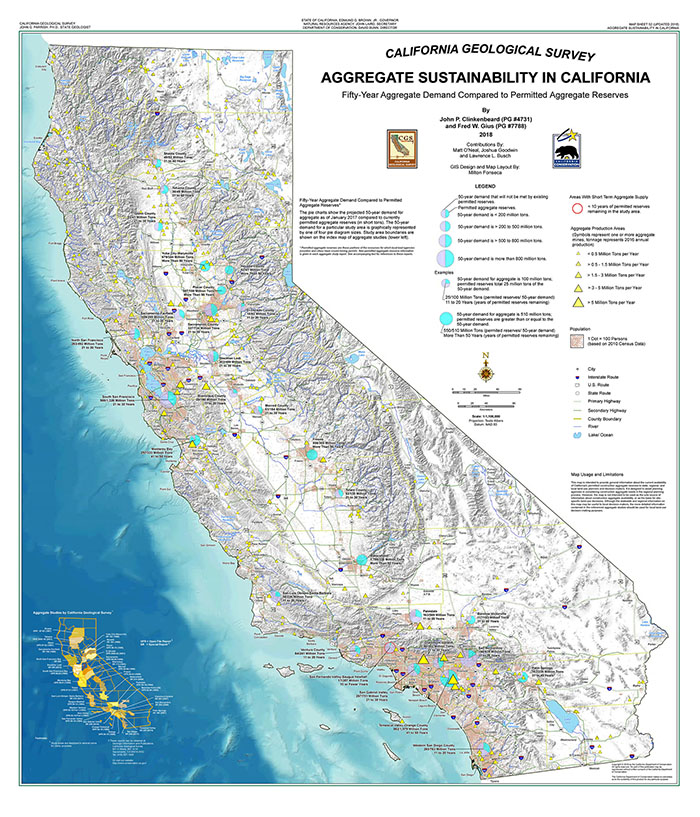2018 Update to Map Sheet 52 - Aggregate Sustainability in California
 by John P. Clinkenbeard and Fred W. Gius
by John P. Clinkenbeard and Fred W. Gius
Background of Map Sheet 52
Sand, gravel, and crushed stone are “construction materials.” These materials, collectively referred to as aggregate, provide bulk and strength to portland cement concrete, asphaltic concrete, Class II base, and other aggregate commodities such as subbase, drain rock, and fill. Aggregate normally provides 80 to 100 percent of the material volume in these uses.
The building and paving industries in California consume large quantities of aggregate and future demand for this commodity is expected to increase throughout California. Aggregate materials are essential to modern society, both to maintain the existing infrastructure and to provide for new construction. Because aggregate is a low unit-value, high-bulk-weight commodity, it must be obtained from nearby sources to minimize economic and environmental costs associated with transportation. These factors make information about the availability and demand for aggregate valuable to land-use planners and decision makers charged with planning for a sustainable future for California’s citizens.
Map Sheet 52 was originally published in 2002 and subsequently updated in 2006 and 2012. Map Sheet 52 (2018) is an update of the version published in 2012. The estimates of permitted reserves, aggregate demand, and years of permitted reserves remaining are based on conditions as of January 1, 2017.
Summary of Map Sheet 52
Map Sheet 52 is a statewide overview of projected future aggregate needs and currently permitted reserves. The purpose of the map is to compare projected aggregate demand for the next 50 years with currently permitted aggregate reserves in various regions of the state. The map also shows the projected years of permitted reserves remaining and highlights regions where fewer than 10 years of permitted aggregate supply remain.
The following conclusions can be drawn from Map Sheet 52 (2018) and the accompanying report:
- In the 30-year period from 1987 to 2016, Californians consumed an average of about 180 million tons of construction aggregate (all grades) per year or about 5.3 tons per person per year.
- In the next 50 years, the study areas identified on Map Sheet 52 will need approximately 11 billion tons of aggregate.
- The study areas currently have about 7.6 billion tons of permitted reserves, which is about 69 percent of the total projected 50-year aggregate demand identified for these study areas. This is about 10 percent of the total aggregate resources located within the study areas.
Comparing regional needs to available reserves and resources demonstrates the important aggregate resource issues facing lead agencies in California. These issues include the need to plan carefully for the use of lands containing these resources and the need to consider the permitting of additional aggregate resources before currently permitted deposits are depleted.
Map Sheet 52 and its companion report are available as free downloads or as printed products; prints are $25 each, plus $8 to cover shipping. (NOTE: the map measures 36 inches by 42 inches.) To purchase printed copies, contact our
Publications Sales Desk.
NOTE: Aggregate reserves and projected aggregate demand shown on Map Sheet 52 are updated from mineral land classification reports published by CGS between 1979 and 2017. Although the statewide and regional information presented on the map and in the accompanying report may be useful to decision-makers, it should not be used as a basis for local land-use decisions. The more detailed information contained in each of the aggregate studies employed in the compilation of Map Sheet 52 should be used for local land-use and decision-making purposes.
